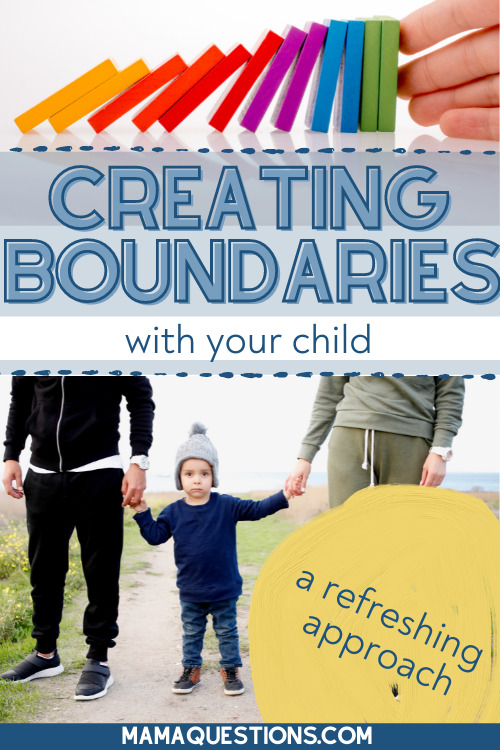I was recently reading a book about healthy boundaries with children. It made me think of my own relationship with my son and how I have been trying to set healthy boundaries that allow space for flexibility and structure in our interactions.
This is a refreshing approach in a day when parents are often judged for appearing passive, especially in the presence of their child’s tantrums!
Disclosure: Some articles on this site may contain affiliate links, meaning, at non additional cost to you, Mama Questions may earn a commission iff you click through and make a purchase. As an Amazon Associate we earn from qualifying purchases.
ps. –>this was the book

What are boundaries and why are they important for both children and parents alike

Often when we talk about setting boundaries as parents, we think it’s about controlling our children, instead, it’s about communicating with them what your values are. Boundaries define who we are and how we interact with others. They give us a sense of security and stability, helping us to trust that people will respect our personal space and not cross over into harmful or abusive territory.
–>This is how to shift to a more respectful way of parenting<–
Boundaries are a social construct, meaning we are not born with an inherent knowledge of healthy boundaries. It is our role to help our children navigate the benefit of them, both respecting others’ boundaries as well as setting them for themselves. (because gosh! it’s not easy!)
For children, boundaries provide them with a sense of safety in the world. They teach them what is acceptable behavior and what is not. When boundaries are healthy, children learn to trust that their parents will protect them and meet their needs. This builds a foundation of security that the child can carry with them into all future relationships.
Example of Boundaries between parent/child:
- It’s important to me that you are safe, therefore I need you to sit on the chair instead of jumping
- I can’t let you hit me, I will block you until you stop
- We all need to brush our teeth 2x/day, but you can choose to do so before or after we change clothing.
- It’s important to me that we speak kindly to each other, I will help you when you ask nicely.
The different types of boundaries that can be established between parents and children

Boundaries are found in all areas of our lives, from personal space to time and energy. They can be physical, emotional, or verbal. boundaries are established based on what our values are. Below are 3 main categories under which boundaries can fall.
Physical Boundaries might include setting limits on how close we allow someone to stand next to us or what kinds of physical contact are allowed (hugs, kisses, roughhousing).
Example of physical boundaries :
- I need you to stay seated in the car until we get home
- I can’t let you touch the stove, it’s too hot
- We have to go to bed at this time every night
Emotional boundaries help us protect our feelings. We might communicate that we don’t want someone to criticize us or make us feel bad about ourselves
Emotional Boundaries help us protect our emotions from being overwhelmed by others. We may set emotional boundaries by communicating that we need time alone or that we don’t want to talk about certain subjects.
Example of emotional boundaries:
- I am not ready to talk about what happened. Maybe tomorrow
- I need some time alone, can we play later?
- I don’t feel good when you yell at me
Verbal boundaries involve the words that we choose to say (or not say) to others. We might use verbal boundaries when we feel like someone is crossing our personal space or when we want to communicate our feelings honestly and directly.
It’s important to note that boundaries can change over time. What might be appropriate for a two-year-old may not be suitable for a nine-year-old. As our children grow and develop, we need to continually adjust the boundaries we have in place to reflect their changing needs.
Example of verbal boundaries:
- Please don’t use mean words when talking to me.
- I will only help if you ask nicely.
- It’s hard to hear what you are saying when you scream.
–>Struggling with enjoying Motherhood? Then read this<–
How to create boundaries with your child in a way that is respectful for both parties

It is important to differentiate between setting boundaries and falling into power struggles with your child. Boundaries should never be used as a way to punish or control our children. Instead, they should establish what the family values are. Choose your boundaries wisely.
When setting boundaries with your child, it is helpful to keep the following things in mind:
Boundaries should be reasonable and achievable
Some boundaries will be set based on your child’s age. For example, you might expect your high schooler to help around the house on their own, but instead, have your toddler play while you clean up.
Other boundaries are time-less. These include not yelling at people, not hurting others or ourselves, or allowing your child to say no to others when it comes to their own physical space.
Boundaries should reflect your values
When creating boundaries, make sure they reflect what you believe in as a family. This might include things like being kind to one another, healthy eating habits, or bedtimes.
Boundaries should be communicated clearly and consistently, otherwise, your child will get confused.
For example, if you communicate to your child that you don’t have the energy to read all 3 books at bedtime if they run away from getting ready, you need to keep it.
If you still read all 3 books after an hour of mischievousness, the boundary no longer has values.
You might also like:
- 7 Best Gentle Parenting Books To Help With Your Stubborn Toddler
- 11 Reasons Why Spanking Does Not Work- And What To Do Instead
- 8 Blog Posts to Help Moms Practice Gentle Parenting with Their Toddlers
You need to be ready to hold the boundary if met with resistance
Do not set a new boundary with your child if you are not ready to hold it. It is very normal for our little ones (and adults for that matter) to challenge our boundaries. Especially when it affects them personally.
One morning I held my foot down with my toddler on a boundary and all hell broke loose. Whatever you are imagining, it was even worse! But I held it and eventually (hours later), it blew over.
It was exhausting both emotionally and physically, but holding that boundary which was a fair one that was set with a clear warning had a positive impact on our relationship. It made my son feel safe that I mean what I say. He behaved better than normal for the next 24 hours.
Tips for maintaining healthy boundaries with your child as they grow older

The best way to continue healthy boundaries with your child is to make sure you have established healthy boundaries for yourself. Our offspring look at us more based on what we do, rather than what we say. (Self Care is a great place to start!)
Learn to be flexible with your child. Remember that boundaries are based on values, so before you throw out a boundary that might instigate upsetness with your child, ask yourself if this is something I truly believe in.
Be clear and consistent when communicating boundaries to your child so they know what to expect. You need to share the boundary, your expectation around that boundary, and what will happen if they break it.
Let’s say it’s important to you that no one throws food on the floor. That is a family value and worth setting a boundary on. To communicate this to your child break it up the following way:
-Boundary: It is important to me that we be respectful of the food set on the table
-Expectations: I expect that you keep the food either on the plate or in your mouth. We will not throw food on the floor.
-Consequence: If you throw food on the floor, I will put your food away. If you throw the food, you are telling me you no longer want to eat.
Setting boundaries is hard but rewarding

Setting boundaries with our children is one of the most important jobs we have as parents. Boundaries help to create a safe and secure environment for our kids, while also teaching them about their own limitations and how to respect the limits of others.
Establishing healthy boundaries can be tricky, but it’s worth taking the time to get it right. The tips we’ve shared should help you start thinking about how you can set boundaries that work for your family in a way that is respectful for both parties involved.
And if you need more help, don’t forget to download our free printable guide on gentle parenting for beginners!

Get insider knowledge on why your toddler’s behavior is so irrational sometimes– and step by step ideas on making parenting easier.
This Value Packed Bundle Includes:
- 5 Steps To Being A More Gentle Parent
- 10 Mindset Shifts To Reconnect With Your Toddler
- Parent’s Guide To Defusing Meltdowns
- 5 Parenting Books That Changed My Life
plus receive a FREE audio book with an audile trial link enclosed
ps. you might still cry in the bathroom sometimes, but after using this resource it will be easier to bounce back on your feet!
ALL FOR FREE — download below!

